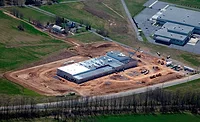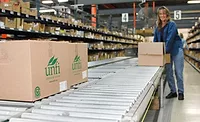Building a Future Food Factory, Part 6: Legal Issues
When selecting a site for a new food or beverage plant, be prepared for legal issues.

Food Engineering’s 2018 Plant of the Year Kraft Heinz’s Davenport, IA facility was built on land in the Eastern Iowa Industrial Center, which offers certified development sites.
Photo by Vito Palmisano.
In this series, we are taking a look at the site selection process and what to consider when choosing a location for your new food or beverage plant. All of these articles are based on the presentation made at the 2017 Food Automation & Manufacturing Conference by Karl Linck, vice president of engineering for Sargento Foods.
In part five, we discussed how to get the workers you need to run highly automated food and beverage plants. Now, we turn to the legal component of the site selection process and the issues that could get you into trouble if not carefully considered.
See more articles in this series:
“If you have something like a purchase agreement for the land,” says Linck. “This is an effort where you need lawyers.”
Linck says many land purchase dealings have given him problems in the past. He gave one example where he tried to buy land needed for access to a certain part of his plant. But when he searched for the owner, it appeared no one owned it. Eventually, it turned out that a railway was abandoned and this piece of land was used at different times by three companies that had all went bankrupt.
“I couldn’t get anyone from any of those three companies to say ‘Well, we might’ve owned it, but we don’t own it anymore,’” Linck says.
The reason for this cat-and-mouse game is because none of the companies wanted to be liable in the event that something was wrong with the land.
“So I eventually had to get it condemned,” Linck says.
That entire process took four years to achieve. However, when Sargento went to buy another piece of land, not too far away, there was another problem.
“It was a little corner, carved out from the main land, and I wanted to include it back into the property,” he says. “A guy was paying taxes on it for 35 years, so we went to get the deed squared away, and turns out he doesn’t own it.”
Even though the county had been charging this person taxes on the land and he thought he owned it, he actually didn’t, but instead the heirs of the legitimate property owner were the actual owners, and they had died. This whole process has taken over two years to sort out.
“You run into these things, and you need lawyers for that,” Linck explains.
Development agreements are another area where lawyers are crucial since the language is very difficult to understand. This is also proving to be the case in interpreting the new FSMA regulations, an area where lawyers are increasingly playing a role.
“There are actually some things we don’t quite understand yet around site security and the requirements around FSMA,” he says. “If you have a guard shack and (security) things like that, you’re good. But a lot of plants don’t.”
Plus, he says if you want to be certified by a standard like BRC or SQF, don’t forget their site selection requirements.
Additionally, the Department of Natural Resources (DNR) or Department of Ecology is another organization that is important to consider. For example, an actual statute for the state of Washington’s Department of Ecology states that if someone feels an industry-created odor present in their backyard prevents them from enjoying their backyard, the manufacturer must take reasonable measures to prevent the odor.
“Let me translate that to reality: If I’m producing garlic Alfredo sauce and someone a quarter mile away is offended because their steak smells like garlic when they are cooking outside, I will get a $25,000 fine if I don’t take care of it,” explains Linck. “That’s a real-life case.”
He says the most important part about this in site selection is what the statute doesn’t say—who was first.
“When you talk about site selection for a plant, automation or not, and you’re going to have an odor or ammonia or anything that is going to float across the air or interfere with the enjoyment of somebody, you have an issue,” says Linck. “So, if you’re locating your plant and it’s not zoned well and you get a big residential area surrounding it, you’ll get complaints. And guess who is at fault?”
Another entity to consider is the US Army Corp. of Engineers.
“You do not want to work with this group. You will have to work with this group if you are in a stream or wetlands. But they are absolutely rigid,” Linck says.
Some of the other regulatory bodies that might be looking at your plant are: EPA, USDA, Department of Agriculture and OSHA.
“OSHA’s biggest impact on site selection is your RMP, or your Community Right to Know, especially if you’re using ammonia. This is where the buffer space can become really important because an ammonia cloud…dissipates extremely quickly and you don’t want to have neighbors, especially residential, close by in that case,” he says.
However, to avoid some of these pitfalls, Managing Director of Austin Consulting Frank Spano says processors should consider selecting a site that has undergone a detailed food certification program.
By choosing one of these sites, the process can uncover critical information before selecting a site, including the identification of a site owner who has agreed to sell the site at an established price. Also, all important zoning and permitting processes will have been collected, including which state and local agencies have jurisdiction over which permits and inspections.
And regarding Linck’s point about the importance of a site being zoned well, a certified food site will allow the processor to see existing land uses to ensure compatible neighbors for food and beverage manufacturing.
Looking for a reprint of this article?
From high-res PDFs to custom plaques, order your copy today!







